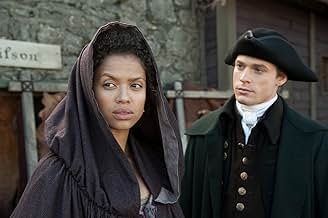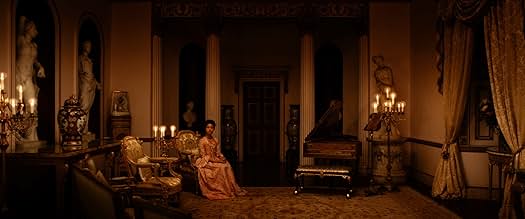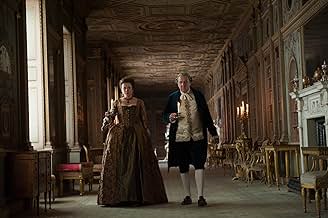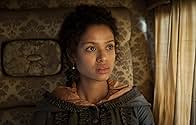La figlia di razza mista, Dido Elizabeth Belle, del capitano della Royal Navy Sir John Lindsay è cresciuta dall'aristocratico zio Lord William Murray, Primo Conte di Mansfield nell'Inghilter... Leggi tuttoLa figlia di razza mista, Dido Elizabeth Belle, del capitano della Royal Navy Sir John Lindsay è cresciuta dall'aristocratico zio Lord William Murray, Primo Conte di Mansfield nell'Inghilterra del diciottesimo secolo.La figlia di razza mista, Dido Elizabeth Belle, del capitano della Royal Navy Sir John Lindsay è cresciuta dall'aristocratico zio Lord William Murray, Primo Conte di Mansfield nell'Inghilterra del diciottesimo secolo.
- Regia
- Sceneggiatura
- Star
- Premi
- 13 vittorie e 32 candidature totali
Recensioni in evidenza
This is essentially a Jane Austen story, set a generation earlier and with a racial element thrown in. The film centres on Dido's emotional relationships. She is sought in marriage by Oliver Ashford, the younger son of an aristocratic family, but his interest is largely financial and the match is fiercely opposed by his mother and his elder brother, both of whom object to the idea of a mixed-race woman marrying into their family. The great love of her life is John Davinier, a clergyman's son, an aspiring lawyer and an ardent anti-slavery campaigner.
At her uncle's stately home Kenwood House, Dido is placed in a strange and anomalous position. By reason of her fortune she is an insider, part of England's establishment; Mansfield even worries that, because of the disparity in their financial positions she might be "marrying beneath herself" if she accepts John. Her race and her illegitimacy, however, make her an outsider. She is allowed to dine with the family when they are alone, but is forced to eat separately when they have guests who might be upset by the sight of a black face. Her position contrasts strangely with that of her cousin and close friend Lady Elizabeth Murray, another niece and ward of Lord Mansfield. Elizabeth is legitimate, but has no fortune of her own, having been virtually disowned by her father under the influence of his second wife. Yet because she is white there can be no question of Elizabeth having to dine apart from the family.
Set against the love of Dido and John is a subplot about what became known as the "Zong case". When sickness broke out on a slave ship, the captain ordered the crew to throw the slaves overboard. When the insurance company refused to compensate the ship-owners for their losses, the owners sued. Lord Mansfield was the judge who heard the case in the Court of King's Bench.
Tom Wilkinson has given a number of fine performances in recent British films (and sometimes in Hollywood too), and this is one of his best. In his dealings with Dido, whom he loves dearly, Mansfield is torn between his inner decency and the need to conform to the social proprieties of the period. In legal matters he is equally torn between the demands of the law and those of justice, which is not always the same thing. In the "Zong" case he is well aware that, in refusing to pay out on the policy the insurers are motivated by commercial considerations, not humanitarian ones; if they had any humanitarian feelings they would not have become involved in facilitating the slave trade in the first place. Nevertheless, he is equally well aware that a decision against the ship- owners will be seen as a victory for the growing anti-slavery movement and a step on the road to the abolition of the slave trade. Other good performances come from newcomer Gugu Mbatha-Raw in the leading role, Penelope Wilton as Lord Mansfield's sister and Sam Reid as John.
The film has something in common with "Amazing Grace", another film about the abolitionist movement; both tend to suggest that the fight against slavery was something waged by upper-class people in wigs sitting in elegant Georgian drawing-rooms, although "Belle" does at least put a black character at centre stage. Dido, moreover, would have known about the horrors of slavery through personal experience, whereas the likes of John Davinier and Lord Mansfield only know about them at second hand. For this reason I would have liked to see more about Dido's childhood in the West Indies before the death of her mother.
As one might expect of a British costume drama, "Belle" is visually attractive, but it is more than a mere pretty face. The "heritage cinema" genre is sometimes dismissed as a mere exercise in sentimental nostalgia, but it can be much more than that. It can also be (as in much of the work of Merchant-Ivory) a vehicle for exploring significant issues, and in this case manages to explore the questions of race, social class, compassion, justice and freedom. As Lord Mansfield put it, "Fiat justitia, ruat caelum". Let justice be done though the heavens fall. 8/10
- A love story and the value of being honest to yourself is what Belle is about. This movie transports you to the 1700s England. Based on the true story of Dido Elizabeth Belle "Belle", this tale is about a young mulato girl named Belle that is brought into her father's house and caretaker of her great-uncle Lord Mansfield a honorable Chief Judge and wife. Belle has all the rights and privileges of upper society but her face reflects her slave mother and the prevailing social prejudice keeps her from being totally accepted into the formal social circles. At the same time, she befriends her cousin, who she considers a sister and is also given residence to this estate after her mother dies and her father abandons her. This story is beautifully layered with the issues of equality and slavery but is not preachy. It merely shows how the matters of the heart can't be prevented by the color of your skin. This coming of age story is masterfully told. I saw this film as part of the Atlanta Film Festival.
The costumes were so beautiful and some were on display at the Landmark Theater in Los Angeles. The audience clapped and cheered at the end of the movie and were raving about the movie as they left the theater.
Lo sapevi?
- QuizIn real life, Lady Elizabeth Murray married first to George Finch-Hatton, 10th Earl of Winchilsea. Their great-grandson was Denys Finch Hatton, who was played by Robert Redford in La mia Africa (1985).
- BlooperEngagement rings were not used in the late 1700s. They didn't emerge until the 1920s.
- Citazioni
Dido Elizabeth Belle: My greatest misfortune would be to marry into a family who would carry me as their shame.
- ConnessioniFeatured in Belle: The Story (2014)
- Colonne sonorePiano Suite in G Minor, HWV 439, Allemande
Composed by George Frideric Handel
I più visti
- How long is Belle?Powered by Alexa
Dettagli
- Data di uscita
- Paese di origine
- Siti ufficiali
- Lingue
- Celebre anche come
- Belle
- Luoghi delle riprese
- Aziende produttrici
- Vedi altri crediti dell’azienda su IMDbPro
Botteghino
- Budget
- 10.900.000 USD (previsto)
- Lordo Stati Uniti e Canada
- 10.726.630 USD
- Fine settimana di apertura Stati Uniti e Canada
- 106.578 USD
- 4 mag 2014
- Lordo in tutto il mondo
- 16.607.575 USD
- Tempo di esecuzione
- 1h 40min(100 min)
- Colore
- Mix di suoni
- Proporzioni
- 2.35 : 1





































